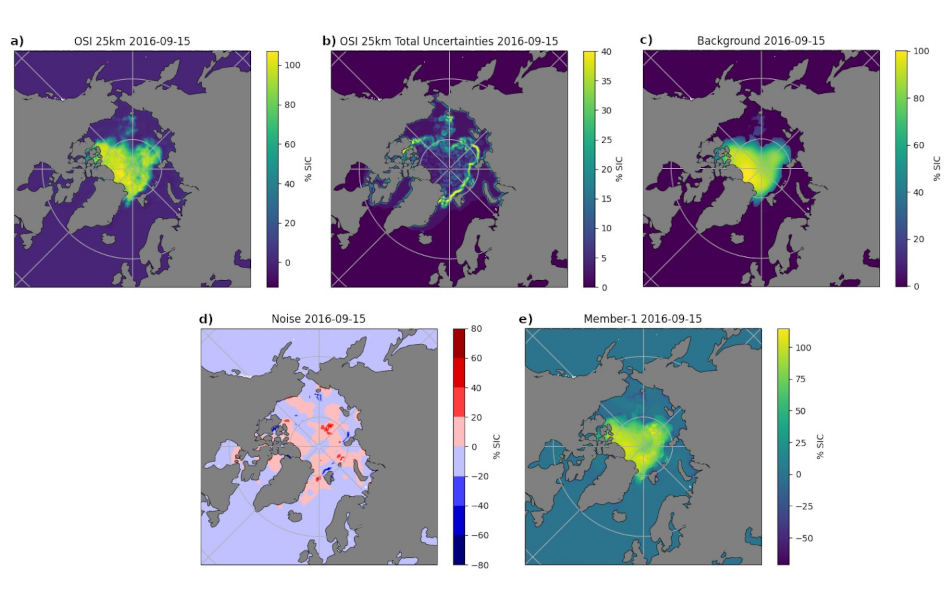19/12/2024
Estimating the uncertainty of Sea-Ice area and Sea-Ice extent from satellite retrievals
-
In the context of the OSI SAF Visiting Scientist Program, Andreas Wernecke from Universität of Hamburg, Germany, worked on assigning realistic uncertainties to integrated quantities such as the monthly mean sea-ice extent and sea-ice area computed from maps of sea-ice concentration. This work took place in 2024 and was supervised by Thomas Lavergne at MET Norway, Oslo, Norway.
-
Figure: Input fields from OSI-450-a, namely sea-ice concentration (a) and total uncertainty (b), filtered background sea-ice concentration (c) and one noise realization (d) as well as resulting noisy sea-ice concentration field (e). All for September 15 in 2016 as example, data shown in (d) and (e) is generated repeatedly to cover the whole range of reasonable sea-ice concentration fields.
-
Objectives and framework of the study
The OSI SAF Sea-Ice Index (OSI-420) displays the polars and regional sea-ice coverage measurements. It includes measures of the sea-ice area and sea-ice extent. The current version of the index is based on OSI SAF Sea-Ice concentration climate products (OSI-450-a and OSI-430-a). Although these sea-ice concentration products are provided with local uncertainty estimates, the index currently has no supporting uncertainty estimate. The purpose of this activity was then to develop a methodology to provide uncertainty estimates for the index. The work was based on a methodology to estimate the correlation length scales and propagate the uncertainties to sea-ice indexes, as proposed in Wernecke et al. (2024).
-
Report conclusions
The method for representing concentration uncertainties is based on the creation of ensembles. The OSI SAF sea-ice index algorithm is then run on each concentration ensemble member to provide an ensemble of index. The report recommends calculating the difference between the area ensemble mean and the corresponding index on a daily basis and remove this value from each area ensemble member. The same needs to be done for the extent. From this the monthly area/extent values for each ensemble member can be derived to estimate monthly index uncertainties.
-
Two possibilities for providing the index uncertainties to the public are then:
-
provide the bias-corrected area/extent ensemble itself
-
provide only the ensemble standard deviations
-
-
The advantage of providing the ensembles of daily and monthly mean area/extent is the added information on the probability distribution which is otherwise lost. If only the standard deviations is provided users will most likely assume a Gaussian distribution of the uncertainties which is largely consistent with our findings but still an assumption which could be avoided. However, providing standard deviations with the daily and monthly index provides easy access and avoids some pitfalls. One such pitfall could be that users combine daily ensemble standard deviations into monthly uncertainty estimates assuming temporal independence, while temporal correlations should be taken into account by deriving monthly-mean area values for each ensemble member separately and then (e.g.) the standard deviation of the monthly-mean-area ensemble.
-
Benefits for the SAF
The results from this Visiting Scientist study will contribute scientifically and technically to the development of uncertainties in the Sea Ice Index product (OSI-420).
-
About this study
Study repport : Uncertainties in sea-ice index
-
Authors
Andreas Wernecke - Universität Hamburg
Thomas Lavergne - Meteorologisk institutt

